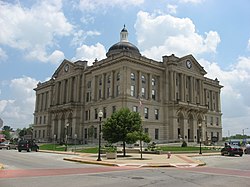2010 census
As of the census [12] of 2010, there were 17,391 people, 6,566 households, and 4,197 families living in the city. The population density was 1,996.7 inhabitants per square mile (770.9/km2). There were 7,487 housing units at an average density of 859.6 per square mile (331.9/km2). The racial makeup of the city was 96.4% White, 0.6% African American, 0.4% Native American, 0.5% Asian, 0.6% from other races, and 1.4% from two or more races. Hispanic or Latino of any race were 2.4% of the population.
There were 6,566 households, of which 34.1% had children under the age of 18 living with them, 45.2% were married couples living together, 13.3% had a female householder with no husband present, 5.4% had a male householder with no wife present, and 36.1% were non-families. Of all households 30.4% were made up of individuals, and 12.5% had someone living alone who was 65 years of age or older. The average household size was 2.48 and the average family size was 3.06.
The median age in the city was 33.4 years. 24.8% of residents were under the age of 18; 13.5% were between the ages of 18 and 24; 25.5% were from 25 to 44; 22.5% were from 45 to 64; and 13.5% were 65 years of age or older. The gender makeup of the city was 47.7% male and 52.3% female.
2000 census
As of the census [4] of 2000, there were 17,450 people, 6,717 households, and 4,419 families living in the city. The population density was 2,091.0 inhabitants per square mile (807.3/km2). There were 7,262 housing units at an average density of 870.2 per square mile (336.0/km2). The main religion is Roman Catholic, with around 42% of the city attending masses. The racial makeup of the city was 97.83% White, 0.21% African American, 0.45% Native American, 0.45% Asian, 0.02% Pacific Islander, 0.30% from other races, and 0.73% from two or more races. Hispanic or Latino of any race were 1.12% of the population.
There were 6,717 households, out of which 33.5% had children under the age of 18 living with them, 48.9% were married couples living together, 12.4% had a female householder with no husband present, and 34.2% were non-families. Of all households 29.0% were made up of individuals, and 12.0% had someone living alone who was 65 years of age or older. The average household size was 2.46 and the average family size was 3.03.
In the city, the population was spread out, with 26.2% under the age of 18, 12.9% from 18 to 24, 28.2% from 25 to 44, 18.9% from 45 to 64, and 13.8% who were 65 years of age or older. The median age was 33 years. For every 100 females, there were 91.5 males. For every 100 females age 18 and over, there were 87.3 males.
The median income for a household in the city was $45,600, and the median income for a family was $56,454. Males had a median income of $35,830 versus $26,921 for females. The per capita income for the city was $21,242. About 5.2% of families and 7.1% of the population were below the poverty line, including 8.2% of those under age 18 and 6.4% of those age 65 or over.








